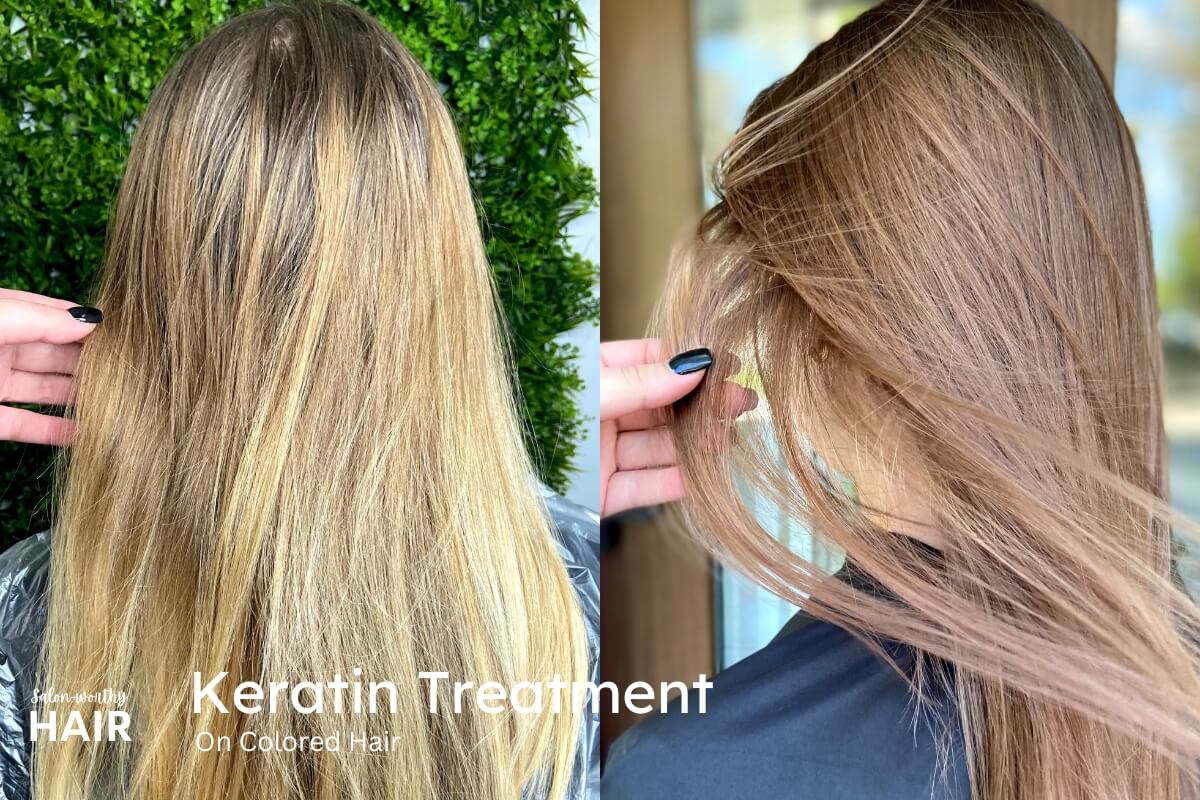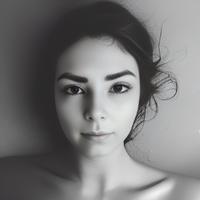Keratin Treatment on Colored Hair: Tips & Precautions
Updated on
This post may contain affiliate links. As an Amazon Associate, we may earn from qualifying purchases.

Doing a keratin treatment on colored hair may sound risky, but ultimately, it’s the timing and condition of your hair that decide whether you can do both treatments on the same day or space them out.
The same applies to Brazilian straightening, hair botox, protein, and Nanoplastia hair treatments. These treatments work by depositing a layer of keratin protein on the hair shaft to smooth and straighten it.
Hair dyes penetrate the hair shaft (permanent) or coat it (semi-permanent), altering the hair’s color by chemically changing the melanin.
In this article, I’ll discuss how to effectively do both treatments for optimal color retention and hair smoothing benefits.
Here is a quick overview of what is covered:
- Doing keratin treatment after coloring your hair
- The time gap to allow before hair coloring and keratin treatments
- Whether keratin can lift or fade your hair color
- Doing both treatments together
- Hair bleaching consideration for unnatural color
- How soon you can color hair after keratin treatment
- Best keratin treatment to use after dyeing your hair
Can You Do Keratin Treatment After Coloring Your Hair?
Yes, you can do a keratin treatment at least 2 weeks (14 days) after coloring your hair, as the timing and condition of your hair are crucial, given the stress both treatments can cause.
Waiting 2 weeks gives your hair time to recover from the chemical process of coloring before undergoing another treatment.
The primary consideration is the health of your hair. A same-day service might be feasible if your hair is in good condition and can handle multiple treatments. But same-day coloring and keratin treatment must be done by a hairstylist who is certified in keratin treatments. You must not attempt to do both treatments at home without supervision.
If your hair is dry, frizzy, damaged, or brittle, it’s better to space out the treatments to allow your hair sufficient time to recover and regain strength. Effective recovery reduces the risk of further damage from consecutive chemical processes.
Does Keratin Lift or Change Your Hair Color?
Some keratin treatments can cause a slight lightening of hair color due to chemical reactions and heat-induced changes in the dye molecules.
The combination of keratin treatment chemicals and high heat can lead to chemical reactions that affect the hair dye. Many hair dyes, especially those that are not permanent, can be sensitive to temperature and the chemical composition of the keratin treatment. The heat from the flat iron, which is used to seal the keratin into the hair shaft, can cause these dyes to break down or change in structure, leading to a fading or alteration of the color.
High temperatures during a keratin treatment, often around 450° Fahrenheit (232° Celsius), can induce oxidation of the color molecules in the hair. Oxidation is a chemical process that can alter the molecular structure of hair dye, leading to a change in color, particularly noticeable in hair dyed with vibrant or red tones, which are more prone to oxidation.
The specific formula of the keratin treatment can interact with the hair dye. Some keratin treatments contain ingredients that can react with the dye molecules when combined with high heat. This reaction can either degrade the dye or alter its color.
After a keratin treatment, the porosity of the hair can change. While keratin treatments are designed to smooth and coat the hair, they can also affect how your hair holds onto color in the long term. Altered porosity might mean hair does not retain dye as effectively as before, leading to quicker fading.
Can You Do Keratin Treatment and Hair Color Together?
It is possible to do a keratin treatment and hair color together. Still, the decision must be based on your hair’s health, the types of products used, and ideally, under the guidance of a professional hairstylist.
The hair color is typically applied first, followed by the keratin treatment. The reasoning behind this sequence is that the keratin treatment can help seal in the hair color, making it last longer and appear more vibrant. However, doing both on the same day can be stressful, so your hair’s condition must be assessed.
Check out this video of a client getting hair color and keratin treatment done in the same sitting by hair colorist Janae Miller.

The color applied is the Pravana permanent dye, followed by the CHI Enviro Smoothing Treatment. I recommend watching this video because Janae Miller shows how carefully she assesses her client’s hair before proceeding with the keratin treatment.
Some salons offer same-day service for both coloring and keratin treatments. Same-day service is usually done for convenience and can be effective if the hair is healthy enough to withstand both treatments. However, using a keratin treatment compatible with hair color is crucial to avoid lifting or altering the color.
Here’s another example of a keratin treatment done on the same day after hair coloring.

Considerations When Your Hair Needs Bleaching
If you are planning to bleach your hair for an unnatural color (like pastels, brights, or vivids), it is recommended to do the hair bleaching treatment first. Once your hair is fully recovered, get the keratin treatment (ideally 2 weeks after), then hair coloring 2 weeks after the keratin treatment.

Coloring Hair After Keratin Treatment
Avoid coloring your hair too soon after a keratin treatment. Applying dye on freshly applied keratin can cause adverse chemical reactions, resulting in patchy hair color, damage, and potentially reducing the effectiveness of the keratin treatment.
Allow enough time for keratin coating to fully bond to your hair shafts, ensuring a strong foundation for the hair dye pigments to stick to the hair.
Read: Wait 2 weeks to dye hair after keratin treatment.
Keratin Treatment or Color First?
Based on general hairstyling practices and the chemistry of these treatments, it is better to color your hair first, followed by the keratin treatment.
Here are the reasons why:
- Sealing in the Color: Applying the keratin treatment after coloring can help seal the hair color. The keratin forms a protective layer over the hair shaft, which can encapsulate the color molecules, potentially making the color last longer and appear more vibrant.
- Avoiding Color Alteration: If you do the keratin treatment first and then color the hair, there’s a risk that the coloring process might strip away some of the keratin. Additionally, the chemicals in the hair dye might react with the keratin treatment, potentially altering the color.
- Hair Health and Protection: Coloring can be harsh on the hair. By doing the keratin treatment afterward, you provide a restorative and protective treatment to the hair, which can help mitigate some of the damage caused by the coloring process.
- Waiting Period: Wait two weeks after coloring before applying a keratin treatment. This waiting period allows the color to be fully set and ensures that the keratin treatment doesn’t interfere with the newly applied color.
- Consultation with a Professional: It’s always best to consult with a professional hairstylist. They can assess the condition of your hair and advise on the best course of action, especially if your hair is damaged or has been processed multiple times.

Each hair type and situation is unique, so while this is a general recommendation, the best approach can vary based on individual hair conditions, the type of color and keratin treatments being used, and personal hair goals.
Best Keratin Treatment for Colored Hair
Hair coloring and keratin treatments are chemical processes that can stress the hair, making the choice of keratin treatment crucial. For colored hair, the GK Hair Formaldehyde-free keratin treatment is an excellent option. This treatment is gentle, free from harsh chemicals like formaldehyde, and is specifically formulated to work well with colored hair. It helps to smooth and strengthen the hair without risking the integrity of the color, ensuring your hair remains vibrant while gaining the benefits of a keratin treatment.
Check out the best keratin treatments for colored hair (Formaldehyde-free).
About the Author
 Tina Moretti
Tina MorettiTina Moretti, a passionate hair care enthusiast with over a decade of expertise, dedicates herself to empowering women with proven hair care advice. Recognized for her hands-on experience and trusted guidance, Tina turns every strand into a statement of beauty and confidence.